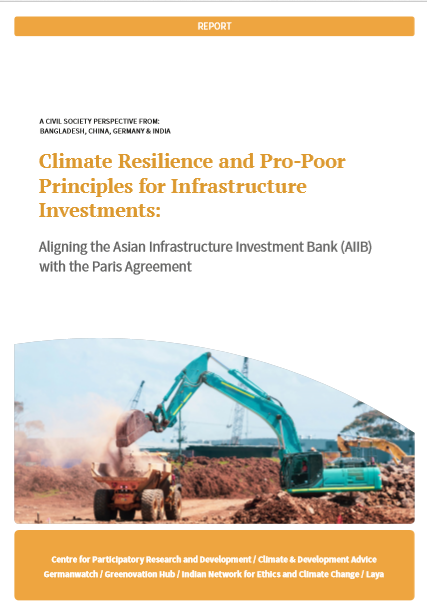Climate Resilience and Pro-Poor Principles for Infrastructure Investments: Aligning the Asian Infrastructure Investment Bank (AIIB) with the Paris Agreement

The 2020s will witness some USD 70 trillion invested into urban, energy, water, ICT, and transport infrastructure. 70 % of those investments will be made in the developing world, mostly in Asia. Infrastructure investments, however, often do not consider in any depth the climate risks their projects are exposed to across their lifespans. Neither is it a standard process to assess whether adaptation options could be integrated into the infrastructure projects so that they actually promote the resilience of the communities they are located in. In some cases, the infrastructure even lowers the resilience of people it is meant to serve.
Climate risks will increase steeply in the decades to come. If we are to leave no-one behind in achieving the SDGs and mitigating climate risks, investments must diametrically shift their focus from business-as-usual infrastructure to transformative, i.e. low-carbon and climate-resilient infrastructure. Multilateral development banks (MDB) have a decisive role to play in shaping the future of infrastructure: Will it be climate-adaptive and pro-poor, or just business-asusual? That question will be explored for the Asian Infrastructure Development Bank (AIIB), the fastest-growing MDB, as an example.
The Paris Agreement (PA), the Sendai Framework for Disaster Risk Reduction (SFDRR), and the Sustainable Development Goals (SDGs) are the main reference frameworks for climate-resilient and sustainable development pathways. AIIB has pledged to align their investments with them. But human rights-based approaches should be added to provide orientation when it comes to the respect for, protection of, and ultimately the fulfilment of the fundamental human rights of those disproportionally affected by climate change impacts. But how can the alignment commitments be realized effectively and lead to tangible results? This report suggests ten Pro-Poor Climate Resilience Principles:
Three Climate Resilience Principles aim at aligning infrastructure investments with the Paris Agreement:
- Do no harm — AIIB infrastructure investments should not undermine the climate resilience of people and ecosystems, especially not of the poor and climate-vulnerable people and be in line with all efforts to limit global warming to 1.5 °C.
- Climate proofing — AIIB infrastructure investments should be protected effectively during their entire lifespan against value loss caused by adverse climate change impacts.
- Enhance systemic climate resilience — AIIB infrastructure investments should be optimized such that they protect human systems and eco-systems against climate change impacts.
These climate resilience criteria should be always applied with a particular focus on the rights and needs of poor and climate-vulnerable people, ensuring that AIIB infrastructure investments expressly contribute to the climate resilience of those who are most in need of it. We propose the following seven Pro-Poor Principles to guide this process:
4. Measurable value for the poor and vulnerable — AIIB infrastructure investments should provide measurable client-value for poor and vulnerable populations in terms of their resilience.
5. Transformation — AIIB infrastructure investments should facilitate the structural transformation to climate-resilient, sustainable development pathways, including poor and climate-vulnerable people.
6. Enabling policy frameworks — AIIB should engage with country clients to support or incentivize the development of enabling policy frameworks to promote climate resilience that takes due note of the rights and particular needs of poor and climate-vulnerable people.
7. Accessibility — AIIB infrastructure investments should ensure access to infrastructure benefits for poor and vulnerable populations.
8. Affordability — AIIB infrastructure investments should ensure affordability of infrastructure services for poor and vulnerable populations.
9. Participation — AIIB infrastructure investments should ensure due participation of poor and vulnerable populations in all phases of the project cycle.
10. Transparency — AIIB infrastructure investments should ensure transparency in all phases of the project cycle, including due consideration of affected poor and vulnerable populations through prior information.
Concrete steps to implement these criteria and principles are proposed with respect to various areas of AIIB’s work, which include project development, selection, approval and implementation, portfolio development, sector policies, strategic programming and budgeting, Environmental and Social Framework, the Risk Management Framework, and result and impact monitoring.
This leads to twelve general policy recommendations on how to put into practice AIIB’s alignment commitment:
Finalize all details of the joint MDB Paris Alignment Framework, including on climate resilience, based on best available science, and taking up the Pro Poor Climate Resilience Principles and related suggestions presented in this report, no later than by the end of 2020;
→ Set a target date soon to align all AIIB policies, strategies, and projects with the Paris Agreement, including its climate resilience goal;
→ Discuss the AIIB’s resilience approaches already in use with the AIIB Board of Directors and test and assess their effectiveness;
→ Review and revise the business plan, as well as the strategic programming, sector strategies, ESF, and risk management frameworks to ensure that all alignments with the Paris Agreement are measurable, reportable, and verifiable, as suggested in this report;
→ Take up the suggestions made in this report with regard to project pipeline development in order to ensure that new investments are climate resilient and pro-poor;
→Make a strong effort to ensure that Covid-19 response measures financed by AIIB are strengthening resilience, including climate resilience, especially of poor and vulnerable people;
→ For all projects, conduct a climate risk and resilience assessment and disclose assessment results, specifically on transition risks and physical risks analyses in project summary documents. The assessments should screen investments for ‘do no harm’ criteria, climate-proofing, and systemic improvement of climate resilience;
→ For all projects, conduct an assessment regarding the application of pro-poor principles, as proposed in the previous chapter;
→ Undertake an additional human rights assessment and identify the most vulnerable groups that might be affected, positively or negatively, by infrastructure investment projects;
→ Based on the experience of lighthouse projects, develop a set of adaptation and resilience indicators to assess the impact and effectiveness of adaptation components in projects;
→ Develop a methodology to quantify physical climate risks. Incorporate those risks into project economic and financial assessments;
→ Incentivize medium- and small-scale people-centred resilience-building and green infrastructure projects. To date there is no specific window for such projects. Allocate a certain budget share for these projects and set a quantitative target (in the initial phase, 2–5 %).
The report concludes with more specific recommendations on how to align AIIB’s infrastructure investments with the PA at the national level, taking Bangladesh, China, and India as examples.
- Publisher: Germanwatch Download

